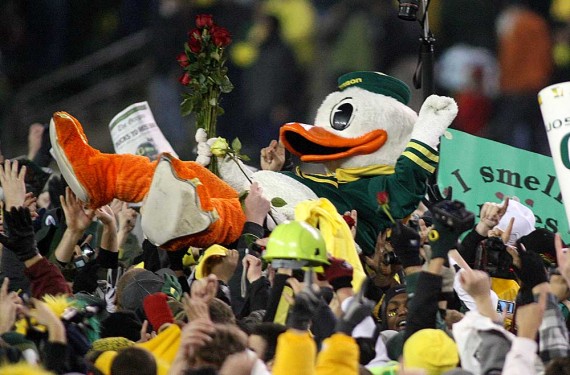Oregon: Plasma Screen Sports, Covered Wagon Academics
While the University of Oregon's athletic programs are flourishing in a seas of green, its academic programs are woefully underfunded.
The Oregon Ducks have finished the regular season undefeated and will go on to play the Auburn Tigers for the BCS football championship. But their academic program is taking some serious shots from fellow PAC10 schools. The Oregonian‘s David Sarasohn thinks they have a point.
But UW athletic director Scott Woodward went in a different direction. First, Woodward went off on the Ducks before the game, suggesting a certain lack of confidence in the outcome. [Justly so; the Huskies lost 16-53. -jhj] Second, instead of the standard “your school is so lame your mascot is extinct” approach, Woodward became as pointed as a tailgate beef skewer. “It’s an embarrassment what their academic institution is, and what’s happened to them as far as their state funding has gone,” said Woodward. “In my mind, it’s a wonderful athletic facility, but they’ve watched it at the expense of the university go really down. “… Any of the rankings you look at, you watch how far (the Ducks have) dropped because of their state funding.”
[…]
Woodward swiftly apologized, and then UW interim President Phyllis Wise ordered him to apologize again, telling him it was a mistake to “criticize publicly another institution’s quality.” She’s not saying he was wrong — just impolite. Wise went on to say, in the comforting tone of a mother assuring someone else’s child that next to last is an excellent place to finish, that the U of O “is an excellent public institution that continues to serve the citizens of Oregon well, particularly in light of diminishing state support.”
[…]
In 2007-08, for public research universities — UO, Oregon State, Portland State — Oregon laid out $3,849 per year per student in state funding. Washington spent $14,002 per student per year, California $14,835 and Arizona $8,262. (It’s not an exact comparison — for example, the other states’ figures include medical schools, which Oregon’s doesn’t — but that’s no more than a holding penalty.) After the Pac-10 expands next year, it will include the University of Utah, where the number was $9,030. It won’t be easy to have the president of the University of Utah being sensitive and understanding about Oregon.
On Woodward’s other point, that the university’s academic funding problems sit next to athletic facilities that are galaxy-class — UO passed “world-class” a while ago — it would be embarrassing if he were revealing a secret. But there’s some reason to think that the faculty has noticed. As two UO professors wrote in The (Eugene) Register-Guard in 2007, “It is worse than ironic that our academic rankings are dropping as our football rankings rise.”
That’ll happen when you’ve got a plasma-screen sports infrastructure and a covered-wagon academic budget.
It should be noted that the Ducks’ athletic teams are so lavishly largely because a young Phil Knight ran track for them under Bill Bowerman. The two would go on to found a reasonably successful sneaker company called Nike. Knight alone has donated $230 million to his alma mater. (Along with, I should note, massive amounts to other arguably more worthwhile endeavors.)
As a PhD graduate of Bear Bryant University (officially, The University of Alabama) I tread lightly here. Then again, despite the public perceptions of the two states, Alabama (and Auburn!) is ranked well ahead of Oregon in the US News rankings. And Alabama has a top tier law school and an internationally renowned medical school; Oregon has neither.
College sports, especially college football, attracts a rabid following — and I’m part of it. But, while alumni, boosters, and national television networks rush to deluge institutions with money for football and men’s basketball, it’s a hell of a lot harder to get the enthusiasm to pay for basic academic programs. Most state institutions around the country have been in trouble for the last two decades or so, gradually cutting their support for higher ed as prisons, old age care, and other demands take more of the budget.
There’s no obvious solution in sight. Margaret Soltan, who pointed me to this story, would doubtless argue that we could begin by shutting down big time football and getting our priorities straight. But, while that might have some ancillary benefits, it wouldn’t solve the state funding issue and might well dilute the one strong tie that binds most alumni to their school after they leave.







As a product of the Oregon system of higher ed and having a son currently attending I would disagree with a blanket statement of it being underfunded. One only has to look at some of the more wasteful programs to see they have money to burn.
There will always be a vocal contingent claiming poverty while attending retreats and taking those valuable sabbaticals talked about earlier. In the public sector there are simply limited resources with what are perceived as unlimited needs.
Uncle Phil does give a lot to athletics but he also gives to the University in general. As the Ducks reach prominence in athletics the criticism of Nike’s relationship will grow. I have my own problem with college athletics but a private individual financing it in such a way isn’t one of them.
So where is any information that Oregon’s academic programs are somehow deficient? I mean besides funding which doesn’t really represent quality, if you look at education in general. Of course, wouldn’t expect an Athletic Director to understand that distinction.
According to collegeresults.org, the Univ. of Oregon isan1100 SAT school that has a four year graduation rate of 41%, a six year graduation rate of 66%, and 18% of the freshmen do not come back for their sophomore year. The school admits 88% of those that apply. The statistics are almost identical for the university of Alabama except that alabama has an almost identical mean SAT while admitting on 63% of the students.
As a note, Oregon is so mismanaged that there not enough dorm rooms for the freshmen let alone everyone else. http://blog.oregonlive.com/breakingnews/2008/05/university_of_oregon_is_out_of.html
People attend poorly run state universities in the belief that they are cheaper but if it takes six years to graduate it is not cheaper and if an entering freshmen only stands 6 in 10 chances of every finishing, versus the Tier I numbers of 90% graduation rates, it is not worth so much.
Not sure what you are unhappy about James, sounds like the GOP idea.
anjin, The Oregon legislature and governors office have long been held by Democrats. Mismanagement is the norm for that particular party.
When I was growing up in Connecticut it wasn’t uncommon to hear University of Connecticut students and graduates complain about the school’s failure to play major league football. Even if they weren’t football fans, they recognized that the lack of meaningful football contributed to UConn’s relatively obscure image outside the immediate region – obscurity which made it more difficult to find jobs elsewhere in the country. Don’t get me wrong, it was scarcely a huge disadvantage, but it existed. The issue gradually went away as UConn turned into a basketball power, and then about ten years ago it finally began playing real football.
As for the University of Oregon’s relatively dismal academic performance, is it one of those state universities bound by law to accept all in-state applicants who meet fairly minimal standards?
Peter, They are not bound by law but have fairly low standards. They also see those freshman as easy money. Graduate students teach them and they drop out before needing real professors or resources. It’s a business model used in many universities.
> Mismanagement is the norm for that particular party.
Plunk… until you show where the Obama administration specifically declared itself to be “anti-business” you are a proven liar. Run along.
anjin-san
I suggest you look at the regulation of carbon dioxide by the EPA. No sane individual or company would propose any expansion in the U.S. for heavy industry when the EPA can kick the crap out of the same company.
You should look at the diverse laws written into financial regulations. The government believes that hiring people based upon their race, gender, or ethnicity is more important than companies creating new jobs or making a profit.
Of course, one of the problem that the University of Oregon has is that there are few new jobs in Oregon so why train people for them.
I have a great deal of familiarity with the U of O as both a student and an employee. It’s very true that the athletics get stupid amounts of money while that actual school has to do with scraps. It’s also true that Knight has donated all kinds of goodies to his pet team. The latest example is the Jaqaa student athlete center which is off limits on the upper floors to anyone but student athletes. Ironically the building was designed so that it looks to have bars all over the outside and a moat surrounding it. Quite a lot of jokes were made about that when the ducks football team players were having one issue after another with the law.
There’s talk around the University of leaving OUS (Oregon University System) as we seem to have been carrying the rest of the state’s schools (we took disproportionately larger hits during the latest budget crises from the economy imploding). I’m not sure if it would really happen, or just how much of an improvement in the school’s finances it would make (or if those improvements would just then be spent on more schwag for the athletes).
Personally I know just one student athlete. She’s nice and throws discus for the track and field, but it was a little grating to hear her talk about all the sweet perks she gets fr throwing a frisbee.
Over the last decade and a half, the University of Oregon has been on a construction binge of both athletic and academic buildings. They had initiated a program called “Campaign Oregon,” which raised over $850 million to help pay for renovations and new buildings in and around the campus area. Part of that donated money includes funds to pay for all the new athletic buildings, but a majority of the funds went into academic buildings, which included building 2 new science buildings and renovating buildings for the music, education, journalism, business, and math departments.
The university and it’s fundraisers did it’s part in getting funds for academic buildings, but the state has reciprocated in providing funds to keep the top-level professors already there. The state spends more money on the prison system than it does on education so if there’s anyone to blame for the lack of institutional quality, it’s the state’s spending priorities. The university has had to take more out-of-state students to balance the budget since the school loses money on in-state students. Phil Knight has joked that Oregon is becoming known as the University of California at Eugene due this high admittance of CA students. If it weren’t for him supporting both athletics and academics, the school would be severely worse off.
It should have said “has not reciprocated” instead of “has reciprocated.”
You have to wonder about the intelligence of California students to pay out-of-state tuition for a mediocre enormous-state-university. I thought that is what Arizona State did for California students.